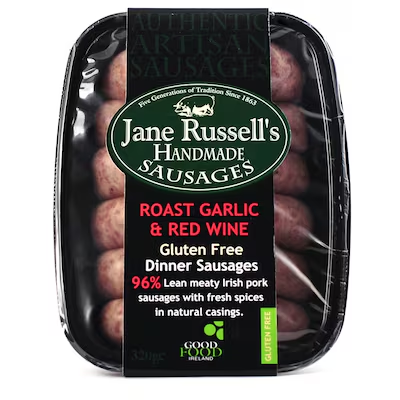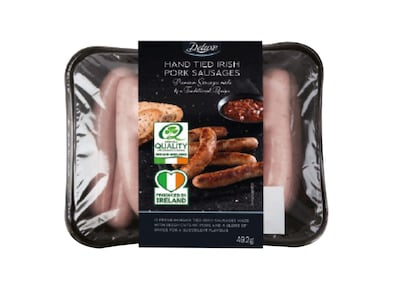The smell of sausages and rashers sizzling in the pan is the smell of an Irish breakfast. It’s a hearty start to the day that can help to keep hunger at bay for hours.
Just what goes into sausages seems like something you might not want to think about.
But is it? What can you tell from the packaging?

It’s a good way to buy Irish because most sausages I found on sale in the supermarkets use Irish pork. Only those sold in Marks and Spencer did not. Then there are those sold in butcher shops too. There are a lot of people making sausages here.
So what makes one sausage different from another? They all taste pretty good in their own way, thanks to the herbs and spices, and sometimes additives too. There are too big differentiators: the percentage of meat and the additives.

How much pork goes into a sausage varies dramatically. Jane Russell’s Roast Garlic and Red Wine dinner sausages, for example, are made with 96 per cent “prime Irish pork”. These are gluten free, but instead of using other filler ingredients, there is just red wine, salt, pepper, roast garlic, spices and sodium sulphite.
It notes that they are “nitrate free”, which is good to know as the International Agency for the Research of Cancer notes that nitrates are probably carcinogenic to humans and are common in rashers. Very few sausages have nitrates, but they do have sodium sulphite, which is a preservative that can give some people breathing difficulties. If there are sausages without sulphites, however, I didn’t find them.
These are unusually meaty sausages, but even Jane Russell’s regular breakfast sausages have 85 per cent pork, which is a far ahead of much of the competition. Those are filled out with pinhead oats, salt, pepper and spices.
Other sausages usually have 60 to 80 per cent pork and it always says so clearly in the list of ingredients. Just don’t be fooled by the ones that say “100 per cent Irish pork” on the front, such as those from Kennys of Newport. It just means that all the pork is Irish. Those are 60 per cent meat.
So it’s worth checking out the back even though sausages that have a high percentage of meat will often mention it on the front too. That’s the case with the packet of Jack & Eddie’s, which have 80 per cent meat. These are filled out with rusk, which is hard bread made from fortified flour. They also have sulphites and sodium ascorbate to keep the meat looking fresh. Then there are spices and E621, which is monosodium glutamate (MSG), the flavour enhancer developed in Japan. It gives a yummy, savoury taste but some people say they react badly to it. The casing is made from beef collagen, which is the structural protein found in the animal’s hide.

You might expect that meatier ones are dearer, but that isn’t always the case. Lidl’s Deluxe hand-tied Irish pork sausages, for example, are 80 per cent pork. These also have rusk, sulphites, sodium ascorbate, MSG and a beef collagen casing. The only extra ingredient listed is triphosphates, which help the sausages to hold added water.
Another meaty sausage is Mallons low-fat, gluten-free traditional Irish pork sausages. These are 75 per cent pork and have just 3 per cent fat. How do they do that? By not adding pork fat, which is the norm with sausages that have less meat.
To make these gluten-free, the wheat found in traditional sausages is replaced with tapioca starch, which is a starch extracted from the root of the cassava plant common in South America and Asia. Irish people have been eating tapioca for many years now, though it used to be served up as a gelatinous pudding that looked like a bowl of tadpoles. These also have a mix of additives, preservatives, flavourings and spices. There is also sugar and dextrose, which is another form of sugar. It is one of the exceptions as most sausages don’t have sugar.
At the bottom of the scale for meatiness are Centra’s Irish pork sausages, which are 53 per cent meat. The second ingredient is pork fat, which will help to make these very tasty. That and the sugar, dextrose and yeast extract added to the usual list of preservatives. Every 100g of these has 29g of fat, and almost 10g of saturated fat. These are the type of fatty, additive-laden processed meat you have been warned about. What surprised me was how often the gluten-free ones proved to be a healthier choice. It always pays to read the label.
Even the best sausages are not a health food.
So it’s not a good idea to have them too often.
FOOD LABELS SERIES
- Bread
- Soup
- Crisps
- Sliced ham
- Cream crackers
(search other food labels articles here)




















